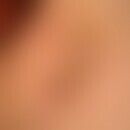DefinitionThis section has been translated automatically.
Histidine-rich structural proteins of the outermost skin layer, which play an essential role in the formation of keratin as matrix proteins The filaggrins are strongly basic, non- or hardly phosphorylated polypeptides with a molecular weight of 35 kDa which can be extracted from the stratum corneum and can aggregate keratin filaments in vitro. They are formed from profile aggrins.
General informationThis section has been translated automatically.
Filaggrin (FLG) is the main component of the keratohyalin granules of the upper str. granulosum. It is present as the 400 kDa protein profilaggrin, which is cleaved by proteolytic differentiation into 10-12 filaggrin polypeptides of 37 kDa in a final differentiation step in the str. granulosum.
Filaggrin is encoded by the FLG gene, which is localized on chromosome 1q21. In addition to the two most common mutations (p.R501X,c2282del4), more than 40 variants are known in this gene. Mutations in the filaggrin gene are associated with atopic dermatitis , among other things.
Phenotypically, these patients with early onset of atopic dermatitis, high serum IgE levels and palmar hyperlinearity can be identified as FLG mutation carriers.
Cyclic citrullinated peptides, which are formed during the degradation of filaggrin (see CCP-AK below), play a pathogenetic and diagnostic role in rheumatoid arthritis (up to 80% positive) as well as in psoriasis arthropathica (10-15% positive).
Note(s)This section has been translated automatically.
Two null mutations of the filaggrin gene manifest themselves in the clinical picture of ichthyosis vulgaris. Null mutations of the gene are detected in 5% of Europeans. 50% of these null mutants lead to dry skin, mild ichthyosis and an increased risk of developing atopic dermatitis .
It is assumed that the cornification and barrier disorder caused by the filaggrin deficiency makes it easier for allergens and microorganisms to penetrate the skin.
A reduced (reactive) expression of filaggrin can also be caused secondarily by pro-inflammatory TH2 cytokines and other exogenous factors.
LiteratureThis section has been translated automatically.
- Henderson J et al (2008) The burden of disease associated with filaggrin mutations: A population-based, longitudinal birth cohort study. J Allergy Clin Immunol121: 872-877
- Hintner H (1985) Filaggrine. Dermatologist 36:608-611
- Novak N et al (2008) Loss-of-function mutations in the filaggrin genes and allergic contact sensitization to nickel. J Invest Dermatol 128: 1430-1435
- Rodrigez M et al (2015) Genetics of atopic eczema. Dermatologist 66: 84--89



